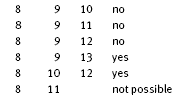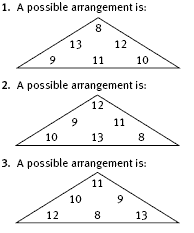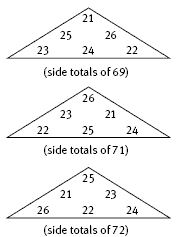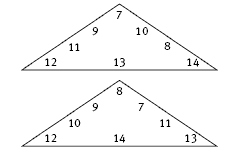This is a level 3 number link activity from the Figure It Out series. It relates to Stage 6 of the Number Framework.
A PDF of the student activity is included.
Click on the image to enlarge it. Click again to close. Download PDF (184 KB)
use mental strategies to sovle addition puzzles
FIO, Link, Number, Book Three, Dive Tank Dilemma, page 24
There are several strategies that could be used for this activity. Some are more efficient and involve more mathematical thinking than others. Your role is to help the students move to more efficient methods as their confidence and ability increase. Discussions about the strategies used is a good way to help the students
think about how they solve problems, and it also exposes them to strategies they may not have considered using.
Possible strategies:
• Guess and check.
Guess: 8, 9, 11 8 + 9 + 11 = 28 not enough, try other numbers
• Guess and improve.
Guess: 8, 9, 11 8 + 9 + 11 = 28 not enough, try a number 2 bigger, that is, swap 11 with 13
New guess: 8, 9, 13 8 + 9 + 13 = 30 correct answer
• Make a table and systematically try all the possibilities.
Start with one of the numbers being 8: 8 9 10 no
Then try with 9: 9 8 13 yes, already have above
• Use logic and reasoning.
If 13 is one of the numbers, the other two numbers must add up to 17. 8 + 9 = 17, so 13, 9, 8 is one group of three. No other pair of numbers adds up to 17 because 8 is the smallest number allowed. Therefore, 13 cannot be at a corner; it must be in the middle. And so on.
Another method using logic and reasoning is this: the average mass of the one tank in a row must be 10. So one row could include one fewer and one more, that is, 9, 10, 11. Another row could include two fewer and two more, that is, 8, 10, 12. 10 is in both sets, so it must be a corner. The only tank left is the 13, which needs 8 and 9 to make 30. So 8 and 9 must be corners too. This gives:
Answers to Activities
Activity One
4a. 21, 22, 23, 24, 25, 26
b. Answers will vary. Some possible arrangements are:
Activity Two
a. 7, 8, 9, 10, 11, 12, 13, 14
b. Two possible arrangements are:






